Wobble Wobble Woo! REVIEW: SONiVOX Dubstep Destruction Tools Software Bundle
REVIEW: It’s not uncommon for software publishers to, at some point, bundle together various previously released products into a newly birthed bundle-of-joy, and SONiVOX has done just this with their recently birthed Dubstep Destruction Tools box set. The bundle, or toolkit as they call it, combines four products: Wobble, the Dubstep Grime Generator; TWIST, the Spectral Morphing Synthesizer; Vocalizer, the Vocal Production Synthesizer; and Pulse, the Advanced Production Instrument.
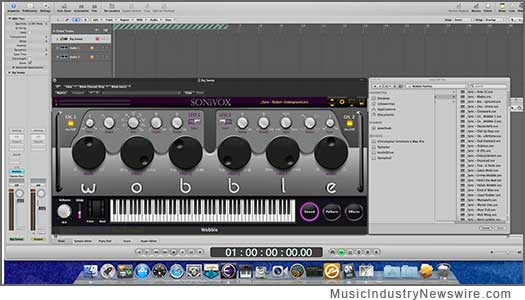
Three of these are somewhat similar in their underlying technology and sound, and one is a quite nice beat machine, that may be more approachable than some other similar products for those comfortable with the Akai MPC interface and workflow.
All work as either plug-ins within any major DAW on Mac OS or Windows, and all will work in stand-alone mode except for Vocalizer (as it needs an audio input track to drive it). Street price for the bundle will typically be around $249, to get price out of the way up front; which is a good deal as they would be about $450 individually, at their current pricing (price may be lower, depending on where/how you find it).
Pulse and Vocalizer have been available for almost 2 years, while siblings Wobble and TWIST were released last year (2011). The jaded amongst you might presume that the company is extending the life of their products by putting them together as a bundle, as the single items have “sold through” and are no longer quite as minty fresh. This is a not uncommon practice, but in actuality the four products do bring together a somewhat juicy batch of funky fresh fun, which you might not have been able to do with your existing raft of plug-ins and DAW presets.
Once you look at the individual products first-hand you might even find the bundle name a bit of a misnomer, although clearly the interface of each product and what it does will seem clearly intended for those more on the groove side of the street, versus classically trained performing musicians. Which is fine, as there’s enough here to suit either side of the production room; both the performers and the tweakers and DJs.
The hype is a bit much for my taste when reviewing the features, ad copy, and company promos for the products found in the bundle/toolkit (“VOCALIZER must be heard to be believed”); and I tend to grimace at any product using “limited only by your imagination” to describe a product feature. To quote the appropriately imaginary hero Han Solo, I can imagine quite a bit. In reality, you’re limited by what the product can do, not just what you might imagine it can do. But I digress. Let’s get on with the show!
WOB WOB WOBBLE
First off, the product most aptly named in relation to the dubstep nomenclature is Wobble, the “dubstep grime generator” (see what I mean about the hype?). I suppose if you trade in terminology like filthy beats, you might want more grime for your dime, and Wobble does one thing, but does it quite well.
According to the box, Wobble is powered by SONiVOX’s spectral morphing synthesis technology. While not fully described in detail anywhere in the slim documentation (on disc, in PDF format only), one might presume that there are a number of sample elements which have been captured using some kind of granular/spectral analysis technology, and the software then changes the sound based on the grains or spectrum of the original sound, and not simply applying filters to a wav or aiff sample pool. Got that?
Or put another way, there may be one sample for a sound patch, and the software resamples in real-time to change the pitch without having a full sample set. Most such technology already imparts a certain bit-crushed digital flavor to the sound, with a bit of phasing, and this lends itself well to the type of sounds most people would presume to use to make a “wobble” effect.
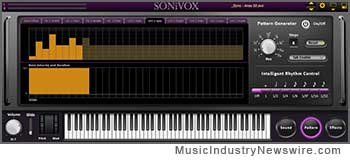 So what’s a wobble? If you’re not well versed, or “skooled,” in certain kinds of electronic music, the wobble is a bass synth sound, which takes the old fart technique of tweaking the filter resonance knobs while playing a bass sequence to give it more or less presence and makes the bass line less repetitive – making it change while repeating through a large number of bars – but goes much further than that.
So what’s a wobble? If you’re not well versed, or “skooled,” in certain kinds of electronic music, the wobble is a bass synth sound, which takes the old fart technique of tweaking the filter resonance knobs while playing a bass sequence to give it more or less presence and makes the bass line less repetitive – making it change while repeating through a large number of bars – but goes much further than that.
Unlike simple filter changes, however, the wobble effect can be more like a stutter edit effect where it can slow down and speed up, while changing resonance and even harmonics. It makes it more “dirty,” by even bit-crushing the sound. This combination of effects can make a repetitive bass line really pump, but it can also be used on melodic lines to make really defining breaks in much the same way a flanger and phase shifter might have been used in the ‘70s to give a drum break that “tunnel of sound” effect. Same idea, really, except you’re trashing your bass line into all kind of sonic territory.
Probably the closest thing many people who don’t regularly listen to “dubstep” music will have heard of this kind of effect would be in the “Transformers” movies, where the robot sounds will do that woggaaa wogga wog wog woggga wogggggggga sound. Or put another way, it’s a pulsing “wob wob wob wob” bass sound that is “wobbling” from one key pressed – so it sounds like a repetition – but is really the single sound being affected by filters. And while it can be locked to the clock, it can also be sub-divided with a timeline to speed up or down in relation to the clock source. Cool, huh?
Wobble promo clip on YouTube:
So, here’s where Wobble comes in. With this plugin, you don’t have to do the heavy lifting. Once you plug it into your DAW, you have a fairly simple set of controls (see screen shots) which allow you to “dial in” changes in real-time, by mapping the big knobs to your keyboard knobs (or MPC controller knobs); or you can run with some of the presets to get a groove happening in a couple of minutes.
For real-time controls, you have six “big knobs” which are (L-R) “width,” “filter freq.,” “filter Q,” impacting Channel 1 and then “filter Q,” “filter freq.,” and “width” for Channel 2.
Above the big knobs are controls for Tune, Waveform Shape, Resolution, Depth, Ramp for Channel 1, and then Ramp, Depth, Rate, Shape and Tune, for Channel 2. Each channel can be switched on/off, and each has a sync option. At bottom left is a glide control which can add a little Roland TB effect on certain patches (on some presets it doesn’t sit well with the pattern).
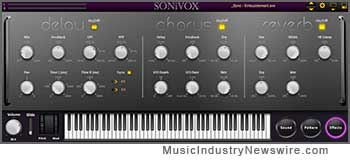 Bottom right are buttons for the Sound screen (default), the Pattern Screen and the Effects Screen (see screen shots of each).
Bottom right are buttons for the Sound screen (default), the Pattern Screen and the Effects Screen (see screen shots of each).
Admittedly there is a bit of “sameyness” to the presets, as this instrument does one thing and appears to have a very basic sound source set to work with (looking in the sample pool I’m guessing less than 100 samples, but I didn’t actually count). It isn’t a sampler, and it doesn’t do re-synthesis of samples you pull off an old TLC record. You can go into the pattern editor to build up a really original sound performance, but it’s not a library of bass sounds, and it’s not a subtractive synth to build up original bass sounds from scratch.
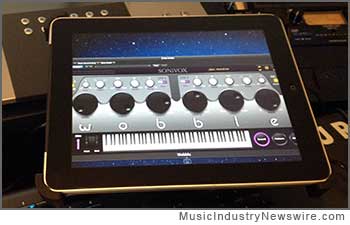 I had a lot of fun with Wobble and immediately found something I would use with my next project. It’s not the most sexy instrument out there, and doesn’t have any feedback like some of the REAKTOR apps on the market with waveform displays or similar, but the knobs work well to change the sound. For some more fun, I dragged the control panel over to my iPad using AirDisplay, and was able to easily control Wobble with the touch panel.
I had a lot of fun with Wobble and immediately found something I would use with my next project. It’s not the most sexy instrument out there, and doesn’t have any feedback like some of the REAKTOR apps on the market with waveform displays or similar, but the knobs work well to change the sound. For some more fun, I dragged the control panel over to my iPad using AirDisplay, and was able to easily control Wobble with the touch panel.
My only quibble would be that it’s not clear whether you can bring in your own samples (in theory, I suppose you could replace one of the samples in the sample pool folder with a new sample using the same file name, to see what happens with that, but I didn’t try it). Also, the method for loading presets is limited to an up-down arrow, and not any kind of pop-up browser. However, you can use the diskette icon to search the preset folder and load a preset by name. I’m guessing here again that there are about 100 presets or so, perhaps less.
While I wouldn’t consider this product a bargain at $150-200 alone, it’s a screaming deal in this bundle. If you already have a large bass sample library or real analog synths, it might be more useful to have a filter effect plugin to impact your own choice of sounds versus the limited number included here, but it does what it does very well.
TWIST AND SHOUT
I won’t spend a lot of time talking about Twist, as this product is almost identical to Wobble, except with a sample pool which is a bit more synth oriented, and has about 200 presets. My opinion is that the two products could almost have been one product, with two “voices” – one for bass and one for synth.
Unfortunately, in this case, the lack of a really large and diverse sample pool really makes this product suffer since there are a finite number of sounds that you can actually create once you exhaust making 10 sub-sets of the same patch.
The application (not shown) is similar to Wobble except it only has five big knobs in the middle, that look like a ‘70s stereo hi-fi receiver, plus 5 small waveform and frequency buttons.
Since its limited by its sample pool, and the FX you can apply to it, along with the pattern generator (the pattern screen and effects screen are identical to Wobble), it’s not limited by your imagination but by the provided sound elements. Still, in the right hands, this is a nice complement to Wobble.
This may sound harsh, but it’s the weakest link in the other items in this bundle, at least for me. Its main value would be in creating more synthy sounds with comparable patterns to beat match and alt-wobble against the Wobble bass patterns you use in your track. In that sense, it can be useful, but I think the sameyness of the sounds on offer due to the pitch shifting engine, is very limiting to its overall usefulness in most production contexts.
Watch a video demo of Twist on YouTube:
VOCALIZER DOES MORE THAN VOCALS
In contrast to Twist, the Vocalizer application is really interesting because it can mangle and morph not just vocals using spectral analysis and pitch shifting, but any kind of audio such as a normal bass line, drum beat, etc.
So, it becomes an interesting break tool for bridges in dance music, a source of remixing ideas when tackling existing tracks to bring interest and excitement to a dance setting, and basically mess with reality in interesting ways.
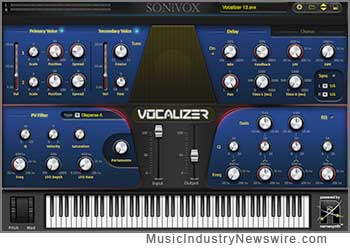 While it has similar properties to a vocoder, it can use any audio for its carrier and rather than simply apply a synth element to the carrier audio, it can actually repitch and reprocess the audio with similar filters and LFOs as found in the Wobble and Twist applications.
While it has similar properties to a vocoder, it can use any audio for its carrier and rather than simply apply a synth element to the carrier audio, it can actually repitch and reprocess the audio with similar filters and LFOs as found in the Wobble and Twist applications.
Another fun way of looking at this application is that it’s very much like a more advanced version of Wobble/Twist where you’re using your own audio (voice, instrument, mixed track, etc.) as the sample pool versus a synth-based sample file. That’s a bit broad for an explanation, but that was my impression since it uses the same Nemesynth engine and can have the same “tonality” to it due to the way it works.
If you look at the controls you can see it has two oscillators for the primary voice (PV), with scale, position (pan), and spread; then there is a companion re-synthesis Secondary Voice (SV) with a coarse and fine tuning and volume control. This can provide a thickening, or minor choir type effect.
In the next section underneath that, are controls for the PV filter, with similar controls to Wobble/Twist: Q, velocity, saturation, freq, LFO depth, LFO rate, along with a “type” drop-down which impacts the filter type overall. On the right side are various controls for Delay, Chorus, and EQ which can help tailor the output sound, minimizing artifacts, or emphasizing the interesting part of the effect.
In center are the typical input/output mix level controls, and a portamento (glide) control. There are also pitch/mod wheels which impact the sound in real-time when playing from a keyboard.
I had a lot of fun applying Vocalizer to an entire mix sans-drums, by making a cloned track, then for a bridge-break I cross faded from the original track to the affected track which made for some really fun results, while leaving the main drum beat entirely clean and pumping along for the footing.
While there are various other products on the market now which do differing kinds of spectral analysis and re-synthesis, Vocalizer gives you some really fun things you can do with both vocals and any kind of sound source.
THE PULSE IS THE THING
Probably the most surprising tool in this bundle for me personally was Pulse, the drum and percussion module. As a long time MPC user (my first drum machine was actually a Korg KPR-77 unit, followed by SCI Drumtraks, then Linn9000, MPC3000, and then MPC4000) I immediately “got” the design philosophy of the product. It’s a drum host and sampling system which is clearly inspired by the Akai MPC legacy, and will feel right at home for those kinds of folk.
While you can record beats live or with a step sequencer, slice and dice samples, add swing and quantize, modulation effects, delay, reverb, and EQ; you also have a retrig feature comparable to the MPC repeat key, loop record, and quite a lot more.
 What makes this surprising for me, is that it’s not trying to be as complicated a product as FXPansion’s Geist, or NI’s Battery, which I find myself often walking away from in favor of Toontrack’s Superior Drummer most of the time. Instead it’s dead simple to use, has a really nice set of sound samples of both acoustic, electronic and FX percussion, and easily loads any kind of wav/aiff file with drag and drop to a pad, even loading multiple samples to a pad and setting the crossfade point for a hard or soft hit. It also loads MPC 3000 sound sets (not documented in the manual, by the way).
What makes this surprising for me, is that it’s not trying to be as complicated a product as FXPansion’s Geist, or NI’s Battery, which I find myself often walking away from in favor of Toontrack’s Superior Drummer most of the time. Instead it’s dead simple to use, has a really nice set of sound samples of both acoustic, electronic and FX percussion, and easily loads any kind of wav/aiff file with drag and drop to a pad, even loading multiple samples to a pad and setting the crossfade point for a hard or soft hit. It also loads MPC 3000 sound sets (not documented in the manual, by the way).
It has both stereo and multi-out plugin modes to make proper mixes and even has A, B, C, D pad banks like a proper MPC.
Once I got that the left file browser was only for dropping samples on pads, and not loading kits (this is done with the file menu top right, consistent with other products in this bundle), the rest was easy to sort out as it has a very MPC mindset to it (which some will appreciate others will not).
In fact, this is an ideal supplement to anybody who owns an MPC, as it creates about the closest thing to a virtual plug-in for the MPC, by inserting this into your DAW and then controlling it from your MPC pads, Q-link dials/faders, etc.
It’s not a stretch to presume some of the thinking here is going into the upcoming Akai MPC plug-in applications with hardware controllers, since SONiVOX is now owned by the same company as Akai. I really like this product and will be using it a lot since it lines up with my MPC way of thinking, easy drag and drop sound building, and great timing response.
When you consider FXpansion’s Geist has the same SRP as this entire bundle, you can start to see a deal here.
Regarding included samples, sounds, and MPC import – to quote the product sheet, which has more detail than the manual in this regard – Pulse imports most MPC file formats including MPC 60/62, MPC 3000, MPC 2000, MPC 2000XL, MPC 1000, MPC 2500, MPC 500, and MPC 5000 as well as AIFF, WAV, BROADCAST WAV, ACID and MP3 files. Pulse includes over 167 premium drum kits and 249 other instruments from SONiVOX’s award winning sound design team.
So, as you can see it comes with a lot of kits, and sounds really good. Major thumbs up on this one!
IN SUMMARY
While I found a lot to like in this package, my only significant complaint with the Dubstep Destruction Tools bundle is the user guide/manuals which have a number of typos (midi vs MIDI), often show the wrong screen shot (Sampla, vs Pulse), and don’t fully describe all the features such as MPC .snd file/kit importation and usage in Pulse, and there are no patch lists for any of the products showing what actual sound assets are included. Particularly with Twist this might be helpful in picking a sound without having to audition them all one by one.
Vocalizer does have some good tutorial videos which make up for the PDF manual limitations, however.
It’s also not clear if you can use your own samples with Wobble or Twist without hacking the sample pool files and replacing them with new sounds of the same file names, or not, which would seem a good thing to know.
I also find it a bit pretentious to provide such a huge 11x10x4.5-inch product box for a single DVD case inside, with no printed manuals, T-shirt or ball-cap (or other swag). Even Adobe doesn’t do that anymore.
Overall for the price this is a great bundle, in my opinion, for new ideas in sound exploration, particularly well-suited to those doing hip-hop, EDM, drum and bass, house and all the variants of that, and especially re-mixes. For MPC users there are some really great things that can be done with Pulse to extend what you already do with your beats, and it’s almost an ideal solution to always having wanted a DAW plug-in to work in concert with the MPC.
PROS:
Great variety of noise-making tools; for beats, bass, wobbly synths, and creative vocal shifting and track mangling. Good value. Worked perfectly on a Mac Pro, running OS X Lion; both in standalone mode and within Logic Pro 9. Authorization was very simple with Internet connection.CONS:
Documentation could be better, both in quality and quantity.PRICE:
Street price for bundle currently US$249 (Aug. 2012).MORE INFO:
http://www.SONiVOXmi.com/index.asp
Article is Copr. © 2012 by Christopher Laird Simmons, and originally published on MusicIndustryNewswire-dot-com before the site was revamped as MuseWire.com in March 2015 – all commercial and reprint rights reserved. Disclosure: No fee or other consideration was paid to the author in relation to the composition of this article/review by the software publisher, however a NFR copy of the product was provided for review purposes.


